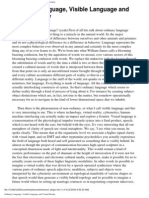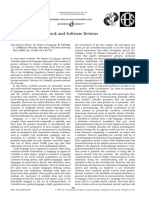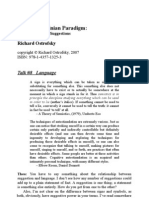Ordinary Language, Visible Language and Virtual Reality
Ordinary Language, Visible Language and Virtual Reality
Uploaded by
danCopyright:
Available Formats
Ordinary Language, Visible Language and Virtual Reality
Ordinary Language, Visible Language and Virtual Reality
Uploaded by
danOriginal Description:
Copyright
Available Formats
Share this document
Did you find this document useful?
Is this content inappropriate?
Copyright:
Available Formats
Ordinary Language, Visible Language and Virtual Reality
Ordinary Language, Visible Language and Virtual Reality
Uploaded by
danCopyright:
Available Formats
deoxy.
org to German find
[an error occurred while processing this directive]
Related to Ordinary Language, Visible Langu...
Ordinary Language,
Visible Language &
Virtual Reality
by Terence McKenna
Language
Shall we talk about language? represents the
First of all lets talk about ordinary language which is probably
most complex
the closest thing to a miracle in the natural world. It's the major behavior ever
neurological manifestation of difference between ourselves and
other animals and primates and it's not a physiological
observed in any
difference it's a difference in behavior. Language represents the animal and
most complex behavior ever observed in any animal and
certainly it's the most complex thing any of us ever learns to do.
certainly it's the
We're born into what William James calls a blooming buzzing most complex
confusion, but by the aquisition of words we mosaic over various
sectors of this blooming buzzing confusion with words. We
thing any of us ever
replace the unknown with the known through the substitution learns to do.
of words and by the time a child is two or three they have
completely created a cultural mosaic of words that is interposed
between them and reality. Reality from that point on is only an unconfirmed rumor brought through the
medium of language and every culture accentuates different parts of reality so that in a sense every
culture is a different reality. Language is the stuff of the world, not quarks or wave-packets or neutrinos,
but language. Everything is made of language. All the constructs of science are actually interlocking
constructs of syntax. So that's ordinary language which seems to define reality through a kind of process
of lying about it. For instance by creating subject-object distinctions which are, in fact, not true to the
matter, but somehow operationally necessary for us to navigate in the kind of lower dimensional space
that we inhabit.
Then there is the phenomenon of non-ordinary, or what I call
visible language and this is very interesting to me. This is where
technology, virtual-reality, cybernetics, human-machine
interfacing can actually make an impact and explore a frontier.
Visual language is a transormation of the physiological impulse
towards syntax into a final product, speech, which is not heard
with the ears, but beheld with the eyes. It's very interesting that
all our metaphors of clarity of speech are visual metaphors. We
say, "I see what you mean, he spoke clearly." This means that at
the organismic level we associate a higher signal clarity with
visual input, and on DMT and other tryptamine psychedelics you
actually experience the field of language both heard and self
generated as something that is visibly beheld. It's almost as
though the project of communication becomes high-speed
sculpture in a conceptual dimension made of light and
intentionality. This would remain a kind of esoteric performance
on the part of shamans at the height of intoxication if it were not for the fact that electronics and
electronic cultural media, computers, make it possible for us to actually create records of these higher
linguistic modalities. In other words it's possible to imagine a virtual reality that was driven by a speech
operated synthesizer where the various parts of ordinary speech adjectives, modifiers, subjects and
objects were interpreted by the cybernetic environment as topological manifolds of various shapes so
that speech would then generate a visibly beheld topology and it's possible to imagine a future world
where in setting up marriage contracts or in negotiating corporate takeovers, in areas where clear
communication, clear expression of intentionality was very important, that people would actually go into
the virtual reality to use the visible language because its capacity for conveying intent would be much
greater than ordinary spoken language. It's not for nothing that Plato connected up the notion of the
Good, the True, and ultimately, the Beautiful. The beautiful of those three concepts is the primary
concept because it is visibly beheld, because it is seen. This is the great convincing power of the
psychedelic experience. That it ultimately appeals to us through the sense that we value most. That we
existentially relate to as the most authentic and that is the visual. Visible language is a kind of telepathy
because if I make a statement in visual language and then you and I regard my statement, we are
somehow, in the act of regarding, made one. Because meaning is not being created out of interiorized
dictionaries which we each consult in the privacy of our own mind but rather
meaning is a visible manifold in the public domain. Meaning goes public and the
differences between people then decline toward being insignificant. It's a kind of
final confirmation of the McLuhan apotheosis and I think visible language is coming.
Life in the imagination is to be the life of creativity carried on through these virtual
environments driven by linguistic engines.
The starships of the future, in other words the vehicles of the future, which will
explore the high frontier of the unknown will be syntactical. The engineers of the
future will be poets. This is what virtual reality holds out to us—the possibility of
walking in to the constructs of the imagination. In a way culture is that. I mean our
cities, bridges, highways, airliners and art galleries are condensations out of the
imagination, but at tremendous cost because we must make them out of matter.
Once we can make them out of light, out of electrons, then we won't build
skyscrapers a hundred and twenty stories high, we'll build them as high as we want.
Roof height will no longer be a factor ruled by cost effectiveness and gravity, it will be a parameter ruled
by the imagination as will all other parameters and then we will discover what man truly is—when we are
able to erect, stabilize. share and explore our dreams in a kind of virtual hyperspace that, carefully
analyzed, is seen to be linguistic. That's what its connectors are made out of, that's what its ferro-
concrete and steel is, is the edifice of language. This is what the stuff of the imagination is made of and I
think this is what we're moving toward. The psychedelic shamans have always known this. Now the
psychedelic underground art community points toward this goal and leads the way.
This is a segue from yesterday's discussion about visible language. The notion being that, well let me
review what yesterday was about. It was about the idea that if we could see language, if language were a
project of understanding that used the eyes for the extraction of meaning rather than the ears, that it
would be a kind of telepathy. There would be both a fusion of the observer with the object observed, and
with the person communicated with. The place in nature where something like this has actually evolved
and occurred is in the cephalopods; the squid and the circoliveral (sp) octopii. These are animals that
divided from the line of development that leads to human beings over six hundred million years ago.
They're mollusks, they're related to escargot, it's an organism very different from ourselves.
Nevertheless, one of the things that evolutionary biologists always talk about is the convergent evolution
between the eyes of cephalopods and the eyes of higher mammals. This is because the cephalopods live
in an extremely complex visual environment and in fact, they have evolved a form of communication that
approximates this visible language that I'm talking about because these octopii have chromataphores all
over the exterior of their bodies. Chromataphores are cells that can change color. Now many people
know that octopii can change color but they think it's for camoflage, for blending in with the
environment, this is not at all the case. The reason octopii change colors in a very large repatoire of
stripes, dots, blushes, travelling shades and tonal shifts is because this is for them a channel of linguistic
communication. In other words they don't transduce their linguistic intentionality into small mouth
noises like we do. Small mouth noises which then move as sound across space in the form of vibrations of
the air. Rather, they actually change their appearance in accordance with their linguistic intent. What this
boils down to is they physically become their meaning, and one octopus observing another is watching
the unfolding of internalized neurological states within the organism being reflected in color changes on
the surface of the skin. Now these octopii not only can change their color because their soft-bodied
creatures. They can also change the texture of their surface from smooth to rugose and folded. They can
also, because they're soft-bodied, fold and unfold and reveal and conceal, very rapidly, different parts of
their body. So they're capable of a visual dance of communication that is an extremely dense kind of
visual signal and in the so-called benthic octopii, the species that have evolved in very deep water where
very little light reaches, they have evolved light-emitting phosphorescent organs, some of them with
membranes like eyelids over them, so that even in the darkness of the abyssal depth of the ocean they
can carry out this dance of light, self-enfoldment, color change and surface texture which is their
linguistic style. In fact the only way an octopus can experience a private thought is to release a cloud of
ink into the water into which it can retreat briefly and hide its mental nakedness from its followers. This
kind of biologically intrinsic wiring into the potential of language is something that we may be able to
mimic and achieve using psychedelic drugs as the inspiration for the direction given to a virtual reality
development program. In other words we might be able to create kinds of visibly beheld syntax that
would be the human equivalent of the dance of light, texture and positioning that constitutes the
grammer and syntax of squids and octopii.
Operationally what these psychedelics do is they dissolve cultural conditioning. Cultural conditioning
is like software, but beneath the software is the hardware of brain and organism and by dissolving the
cultural conditioning to speak English, German, Swahili or whatever, then one returns to this ur-sprach,
this primal language of the animal body and can explore the real dimension of feeling that culture has a
tendency to cut us off from. Culture replaces authentic feeling with words. As an example of this, imagine
an infant lying in its cradle, and the window is open, and into the room comes something, marvelous,
mysterious, glittering, shedding light of many colors, movement, sound, a tranformative hierophany of
integrated perception and the child is enthralled and then the mother comes into the room and she says
to the child, "that's a bird, baby, that's a bird," instantly the complex wave of the angel peacock
irridescent transformative mystery is collapsed, into the word. All mystery is gone, the child learns this is
a bird, this is a bird, and by the time we're five or six years old all the mystery of reality has been carefully
tiled over with words. This is a bird, this is a house, this is the sky, and we seal ourselves in within a
linguistic shell of disempowered perception, and what the psychedelics do is they burst apart this cultural
envelope of confinement and return us really to the legacy and birthright of the organism.
Terence McKenna Land
The Deoxyribonucleic Hyperdimension
DEOXY > CONTACT · NEWS · VIDEO : NEW—WATCHED—RANDOM < > Contact –+o^
<!-- warning: Subroutine My::ProxyRemoteAddr redefined at /var/www/mason/handler.pl line 315. -->
<script src="//archive.org/includes/analytics.js?v=cf34f82" type="text/javascript"></script>
<script type="text/javascript">window.addEventListener('DOMContentLoaded',function(){var
v=archive_analytics.values;v.service='wb';v.server_name='wwwb-
app16.us.archive.org';v.server_ms=284;archive_analytics.send_pageview({});});</script><script
type="text/javascript" src="/static/js/wbhack.js?v=1521067262.0" charset="utf-8"></script>
<script type="text/javascript">
__wbhack.init('https://web.archive.org/web');
</script>
<link rel="stylesheet" type="text/css" href="/static/css/banner-styles.css?v=1521067262.0" />
<link rel="stylesheet" type="text/css" href="/static/css/iconochive.css?v=1521067262.0" />
<!-- End Wayback Rewrite JS Include --><!-- BEGIN WAYBACK TOOLBAR INSERT -->
<script type="text/javascript" src="/static/js/timestamp.js?v=1521067262.0" charset="utf-8">
</script>
<script type="text/javascript" src="/static/js/graph-calc.js?v=1521067262.0" charset="utf-8">
</script>
<script type="text/javascript" src="/static/js/auto-complete.js?v=1521067262.0" charset="utf-8">
</script>
<script type="text/javascript" src="/static/js/toolbar.js?v=1521067262.0" charset="utf-8">
</script>
<style type="text/css">
–+o
You might also like
- Émile Benveniste - Subjectivity in LanguageDocument7 pagesÉmile Benveniste - Subjectivity in Languagedevrandevran100% (1)
- Tara Tainton - You Just Come To MommyDocument3 pagesTara Tainton - You Just Come To Mommydan25% (4)
- Nordic Model PDFDocument10 pagesNordic Model PDFdanNo ratings yet
- Module 1 - Linguistics and Language PDFDocument64 pagesModule 1 - Linguistics and Language PDFAngelou BatallaNo ratings yet
- The Language of Things - Hito SteyerlDocument5 pagesThe Language of Things - Hito SteyerlssdfvrNo ratings yet
- Een19 ModuleDocument150 pagesEen19 ModuleJennylyn AldeaNo ratings yet
- Terence McKenna - Ordinary Language, Visible Language and VRDocument4 pagesTerence McKenna - Ordinary Language, Visible Language and VRgalaxy5111100% (1)
- (Martchev, Milen) Is The World Made of LanguageDocument45 pages(Martchev, Milen) Is The World Made of LanguageAntonio TorízNo ratings yet
- From Hand To Mouth Michael C. CorballisDocument2 pagesFrom Hand To Mouth Michael C. CorballisRhonamae GabisanNo ratings yet
- Eapp 20240324 121505 0000Document5 pagesEapp 20240324 121505 0000Russell AggasidNo ratings yet
- DESIGN FEATURESDocument4 pagesDESIGN FEATURESHafsa TekameraNo ratings yet
- Emerson - Language Has Made You An Outsider - SISSI FinalDocument9 pagesEmerson - Language Has Made You An Outsider - SISSI FinalL. E. C.No ratings yet
- Funcionalna Teorija MimeDocument10 pagesFuncionalna Teorija MimeTeodorKutzarovNo ratings yet
- 2.2 Walter Benjamin On Mimetic FacultyDocument3 pages2.2 Walter Benjamin On Mimetic FacultyAoli WeiNo ratings yet
- The Child and the World: How the Child Acquires Language; How Language Mirrors the WorldFrom EverandThe Child and the World: How the Child Acquires Language; How Language Mirrors the WorldNo ratings yet
- Language As The Main Means of CommunicationDocument7 pagesLanguage As The Main Means of CommunicationLenaNo ratings yet
- From Hand To MouthDocument8 pagesFrom Hand To MouthAbigail MirabelNo ratings yet
- Communication and Language: Informative Signals. Informative Signals Are Those Which Are Sent NonDocument4 pagesCommunication and Language: Informative Signals. Informative Signals Are Those Which Are Sent NonAyman HajebNo ratings yet
- Introduction: Back To BasicsDocument191 pagesIntroduction: Back To BasicselhyamNo ratings yet
- Cooper 2002Document14 pagesCooper 2002Syed Kaab SurkhiNo ratings yet
- .Resumen Del Tema MIODocument7 pages.Resumen Del Tema MIOMaria VazquezNo ratings yet
- PropertiesDocument6 pagesPropertiesRagil Rizki Tri AndikaNo ratings yet
- Origin of LangugeDocument43 pagesOrigin of LangugelicibethNo ratings yet
- Hocketts-Design-Features-of-Language (2)Document4 pagesHocketts-Design-Features-of-Language (2)Jessica WilliamsNo ratings yet
- 2002 The Alphabetic Body Brian RotmanDocument23 pages2002 The Alphabetic Body Brian RotmanTim HardwickNo ratings yet
- Characteristics of Human LanguageDocument6 pagesCharacteristics of Human LanguageWonston YapNo ratings yet
- Kenneth Burke - Theology and LogologyDocument38 pagesKenneth Burke - Theology and Logologyakrobata1No ratings yet
- 01chapter 1 IntroDocument137 pages01chapter 1 Introsusan sunNo ratings yet
- Introduction To Linguistics Assignment 1Document15 pagesIntroduction To Linguistics Assignment 1Tutu SultanNo ratings yet
- Hyderabad Devy ImaginationDocument13 pagesHyderabad Devy ImaginationMeti MallikarjunNo ratings yet
- Compressao Construcao SubjetividadesDocument6 pagesCompressao Construcao SubjetividadesAdriana SilvaNo ratings yet
- Magic of LanguageDocument11 pagesMagic of LanguageHugoNo ratings yet
- Language: Origin and Meaning by John ZerzanDocument7 pagesLanguage: Origin and Meaning by John ZerzanMike McDNo ratings yet
- What Is LanguageDocument4 pagesWhat Is Languageilham3010015No ratings yet
- 01chapter 1 IntroDocument103 pages01chapter 1 IntroShantanu PaulNo ratings yet
- Chapter 1Document64 pagesChapter 1Mhonz LimbingNo ratings yet
- 3 - The Origins and Evolution of Language - Michael Corballis (TedxAuckland)Document3 pages3 - The Origins and Evolution of Language - Michael Corballis (TedxAuckland)cosme.fulanitaNo ratings yet
- Language As A Means of CommunicationDocument3 pagesLanguage As A Means of CommunicationjayceedrewsNo ratings yet
- The Meaning of Silence1Document13 pagesThe Meaning of Silence1lhcollections.idNo ratings yet
- From Hand To Mouth The Origins of LanguaDocument3 pagesFrom Hand To Mouth The Origins of LanguakeishienkeithquimoyogNo ratings yet
- The Power of Language EssayDocument3 pagesThe Power of Language EssaySuleman AliNo ratings yet
- Meaning (Muñoz & Rojo 2018)Document18 pagesMeaning (Muñoz & Rojo 2018)ZogoibiNo ratings yet
- Ae449 CDTN Ngonguvavanhoa A27560 k1n1 2122Document21 pagesAe449 CDTN Ngonguvavanhoa A27560 k1n1 2122Hoàng ĐạtNo ratings yet
- Done By: Fawaz Nahshal & Mohamed AlatrabDocument16 pagesDone By: Fawaz Nahshal & Mohamed AlatrabAhmed altaloolNo ratings yet
- Modality and RepresentationDocument43 pagesModality and RepresentationMariam SinghiNo ratings yet
- Notes On The Humiliation of The Word PDFDocument11 pagesNotes On The Humiliation of The Word PDFStashaNo ratings yet
- StuviaDocument1 pageStuviamahdinassiri740No ratings yet
- The Roots of Language - Paul Ibbotson and Michael Tomasello - Science - The GuardianDocument3 pagesThe Roots of Language - Paul Ibbotson and Michael Tomasello - Science - The GuardianLi-Ern GohNo ratings yet
- Theology and Logology PDFDocument38 pagesTheology and Logology PDFStephen GarrettNo ratings yet
- Introduction To Linguistics - Nature of Language (Handout)Document4 pagesIntroduction To Linguistics - Nature of Language (Handout)Cool FireNo ratings yet
- El Lenguaje Humano Apuntes - Es.enDocument98 pagesEl Lenguaje Humano Apuntes - Es.enDale Crawford-DrakeNo ratings yet
- The Ta Ta Theory StudentsDocument11 pagesThe Ta Ta Theory StudentsLuciannaNo ratings yet
- Hand To MouthDocument4 pagesHand To MouthJem RieNo ratings yet
- Playing With Words: Features Cover StoryDocument4 pagesPlaying With Words: Features Cover StoryHan YiNo ratings yet
- (Let's Make Communication Great Again) - How The Nature of Words Should Impact Your CommunicationDocument15 pages(Let's Make Communication Great Again) - How The Nature of Words Should Impact Your CommunicationAvantika SharmaNo ratings yet
- Excerpt From: Louder Than Words: The New Science of How The Mind Makes MeaningDocument3 pagesExcerpt From: Louder Than Words: The New Science of How The Mind Makes MeaningL. J.No ratings yet
- ED Paradigm 08 - LanguageDocument16 pagesED Paradigm 08 - LanguageRichard OstrofskyNo ratings yet
- Introduction To LinguisticsDocument30 pagesIntroduction To LinguisticsNatalia KaczmarczykNo ratings yet
- Bhathacharya - 1984 - A Picture and A Thousands of WordsDocument34 pagesBhathacharya - 1984 - A Picture and A Thousands of WordsEdson do Prado PfutzenreuterNo ratings yet
- Language Is Communication. DiscussDocument3 pagesLanguage Is Communication. DiscussVincent SamNo ratings yet
- From Hand To MouthDocument20 pagesFrom Hand To MouthTRISTANE ERIC SUMANDENo ratings yet
- Language and LinguisticsDocument32 pagesLanguage and LinguisticsDeden SyefrudinNo ratings yet
- Writing AdviceDocument2 pagesWriting AdvicedanNo ratings yet
- YARN - Unbreakable (2000) Video ClipsDocument16 pagesYARN - Unbreakable (2000) Video ClipsdanNo ratings yet
- Nitrous Oxide - Not A Laughing Matter in Electronics Manufacturing - N2O PDFDocument1 pageNitrous Oxide - Not A Laughing Matter in Electronics Manufacturing - N2O PDFdanNo ratings yet
- New York NY Spirit of Times 1875 Jan-Dec Grayscale - 0004Document1 pageNew York NY Spirit of Times 1875 Jan-Dec Grayscale - 0004danNo ratings yet
- Disquieting Feeling of Strangeness - The Art of The Mentally Ill PDFDocument5 pagesDisquieting Feeling of Strangeness - The Art of The Mentally Ill PDFdan100% (2)
- Notes On Chaucer A Commentary On The Prolog and Six Canterbury TalesDocument352 pagesNotes On Chaucer A Commentary On The Prolog and Six Canterbury TalesdanNo ratings yet
- Friday & Saturday Nights - SAFE RIDE - 7:30p - 2:30a - Sponsored by Bud LightDocument2 pagesFriday & Saturday Nights - SAFE RIDE - 7:30p - 2:30a - Sponsored by Bud LightdanNo ratings yet
- Consuming Fire Wolif Landstreicher PDFDocument18 pagesConsuming Fire Wolif Landstreicher PDFdanNo ratings yet
- Death From Laughter - Wikipedia PDFDocument1 pageDeath From Laughter - Wikipedia PDFdanNo ratings yet
- Jacques Ellul PDFDocument15 pagesJacques Ellul PDFdanNo ratings yet
- Hugo Black PDFDocument4 pagesHugo Black PDFdanNo ratings yet
- Wack Pack: History Official ListDocument3 pagesWack Pack: History Official ListdanNo ratings yet
- Get More FromDocument8 pagesGet More FromRiyad MohssineNo ratings yet
- Pre Test 2nd Quarter g10 Science 20202021Document1 pagePre Test 2nd Quarter g10 Science 20202021RAYMUND RODILLONo ratings yet
- Call Center Zocalo Listas de Precios Primavera - Verano 22 01jun22Document6 pagesCall Center Zocalo Listas de Precios Primavera - Verano 22 01jun22RUTH ROJASNo ratings yet
- 29.wave OpticsDocument43 pages29.wave OpticsRajeshwar rao bNo ratings yet
- Objective: Activity1. Let's Make Waves! What Happens When Waves Pass By?Document4 pagesObjective: Activity1. Let's Make Waves! What Happens When Waves Pass By?Nina Angela Cate100% (1)
- Maharashtra HSC Physics Paper 2 - TargetDocument17 pagesMaharashtra HSC Physics Paper 2 - Targetanujtheterrible100% (2)
- Lb-Aw-Rac-Spt CMT enDocument62 pagesLb-Aw-Rac-Spt CMT enWaldir Donatti JuniorNo ratings yet
- Dual Nature of Light CREAMDocument14 pagesDual Nature of Light CREAMTusharr sgrNo ratings yet
- C QuantDocument4 pagesC QuantCentro Oftalmologico ColombianoNo ratings yet
- Sound and Hearing OpticsDocument40 pagesSound and Hearing OpticsJuliana Bianca Dela VirgenNo ratings yet
- Glass PresentationDocument20 pagesGlass PresentationAmrethesh E.MNo ratings yet
- Camag Catalog 2013 enDocument48 pagesCamag Catalog 2013 enrodrigoNo ratings yet
- How To Convert Lumens To Lux (LX)Document4 pagesHow To Convert Lumens To Lux (LX)ThilakNo ratings yet
- Lecture 7 Installations Tu 1440Document27 pagesLecture 7 Installations Tu 1440monika dhimanNo ratings yet
- Product Specification: Model No. FYM-23881A/BXX-XXDocument5 pagesProduct Specification: Model No. FYM-23881A/BXX-XXAlex VelásquezNo ratings yet
- Magnet Related Info and Links (2/10/19)Document21 pagesMagnet Related Info and Links (2/10/19)Jason Verbelli100% (2)
- Forrest M. Mims III Semiconductor - DiodeLasersDocument191 pagesForrest M. Mims III Semiconductor - DiodeLasersهبة صوالNo ratings yet
- Grade 8 Unit C FITB NotesDocument9 pagesGrade 8 Unit C FITB NotesceNo ratings yet
- Detailed Lesson Plain in Grade 1 SCIENCE DAY 1Document5 pagesDetailed Lesson Plain in Grade 1 SCIENCE DAY 1Nyca Pacis100% (1)
- Science 6 Q3 SummativeDocument3 pagesScience 6 Q3 SummativeEDENLYN DALISAYNo ratings yet
- Determination of Absorption SpectraDocument30 pagesDetermination of Absorption Spectrasay.elleseNo ratings yet
- Revision Sheet With Answers-Science - Gr1 - Term2Document6 pagesRevision Sheet With Answers-Science - Gr1 - Term2nara.alhusseinNo ratings yet
- Led Change The Sense of Lighting: India - Australia - Oman - UAEDocument6 pagesLed Change The Sense of Lighting: India - Australia - Oman - UAEMr. Nirav PatoliaNo ratings yet
- Summary Notes Topic 5 Edexcel Physics GCSEDocument5 pagesSummary Notes Topic 5 Edexcel Physics GCSEbaioma19No ratings yet
- Ee 365 Electrical Services Design. Reviewed CompleteDocument249 pagesEe 365 Electrical Services Design. Reviewed CompleteBismark BosoNo ratings yet
- Science 3 Detailed Lesson PlanDocument6 pagesScience 3 Detailed Lesson PlanAtheena Leerah Agustin LucasNo ratings yet
- Mix TC-0219-BLA: Downlight IP54 Mix LED 6 LED Neutral-White 4000K White Black 494Document18 pagesMix TC-0219-BLA: Downlight IP54 Mix LED 6 LED Neutral-White 4000K White Black 494Javier LeonisNo ratings yet
- Lab ReportDocument2 pagesLab ReportJiaqin LohNo ratings yet
- Notes The Possibility of Mass Shift Into The Past Anthony MacciniDocument2 pagesNotes The Possibility of Mass Shift Into The Past Anthony Maccinipierreantonio6No ratings yet







































































































